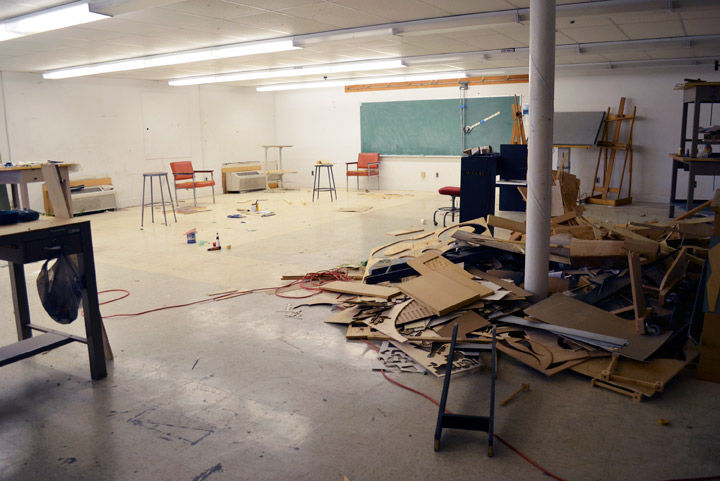Bidding the Blue Barracks goodbye
December 15, 2015
Years after being installed as temporary structures, the long, blue, metal buildings with purple doors tucked between East Campus, Charlotte West Stadium and Route 51 have reached the end of their career.
Phil Gatton, director of physical plant, said, in the spring, the university plans to demolish the Blue Barracks, which used to house the School of Art and Design and Architecture classes.
The Blue Barracks were constructed in 1973 with intentions of temporarily accommodating for a loss of space after Old Main burned down in 1969, said Gatton.
Advertisement
“Here we are, forty years later,” he said.
Gatton said the amount of money put into maintaining the temporary buildings was much greater than their value.
“It was embarrassing for the university as a recruiting tool,” he said.
Joseph Mckinney, a senior from Union, Mo., studying architectural studies, said he never liked the barracks, which were used this semester as a place for architecture and design students to build projects.
Mckinney, who is a woodshop attendant, said he spends time in the barracks every day, where he cleans the shop and helps students use different machines.
The barracks, which do not have Wi-Fi, are cold in the winter and hot in the summer because the heating and air conditioning unit does not work, Mckinney said.
Walter Wendler, director of the School of Architecture, said the woodshop and freshman design studies and digital fabrication labs, the last programs to be housed in the barracks, are in the process of moving to Quigley Hall’s basement.
Advertisement*
This was the first semester no classes were held in the barracks, which Wendler called “old and dilapidated.”
The School of Art and Design was also housed in the barracks until it moved to the renovated pool area of Pulliam Hall last year.
This week, the university is in the process of moving the machinery from the barracks into Quigley’s refurbished basement.
Gatton said the University spent about $9 million on renovations to Pullium, and about $1 million on Quigley. He said the final phase, demolishing the barracks, will cost about $400,000.
However, Wendler said he does not believe the facilities had much of a negative effect on the program.
“We have very strong faculty teaching the first year of design,” Wendler said. “In spite of the facilities we were in over at the Blue Barracks, we still offered a very fine learning experience for students.”
Wendler said the new space is a grand improvement.
Kay Zivkovich, a communication design professor at the university, said, despite their conditions, the barracks allowed her some unique teaching opportunities during her 25 years teaching in the barracks.
She said one year her environmental graphic design class upgraded the inside of the barracks where there were holes in the wall and un-numbered rooms. She and her students also created a mapping and signage system for the un-numbered rooms inside.
“It’s lived its lifetime,” Zivkovich said. She said their are also issues with mold and rodents.
Mckinney said taking classes in the Blue Barracks was almost like a rite of passage for underclassmen, but he said the change is much needed.
“You could make a mess without having to worry about it too much, which is how we used it for the past twenty years or so,” said Stewart Wessel, a professor of architectural studies and interior design.
Wessel, who has been a faculty adviser at an architectural studio shop in the barracks since 1996, said even though there were drawbacks to the buildings, like sometimes sometimes walking into a room and finding a squirrel or raccoon. He said he believed students and faculty had a little more freedom to make a mess and get a little more creative about their designs and projects.
“I’ll miss that kind of autonomy where we could go to the barracks and kind of get away from everything else and just concentrate on the job at hand,” Wessel said.
However, he said it will be helpful that the shop is now in the same building as the studios, which is more convenient.
“Students can come down and work on something in the shop during their regular studio hours without having to walk across the tracks and through the parking lots to get to the barracks,” Wessel said.
He said some of his fondest moments in the barracks were the late nights he spent working with students on their projects.
But he said he does not believe this will end just because the barracks do.
“When anything’s new, you have to feel your way through it at first,” Wessel said. “But I think the facilities will lend themselves to better projects.”
Anna Spoerre can be reached at aspoerre@dailyegyptian.com or 618-536-3325
Advertisement









